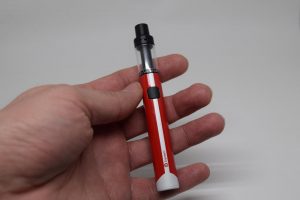EVALI Study Finds Majority of Victims Vaped THC, Still Blames Vaping in General
The first ever study to look at chest X-ray and CT imaging of teens diagnosed with the dreaded EVALI respiratory condition was recently published in the medical journal Radiology. Despite finding that over 90 percent of the patients involved in the study having reported vaping tetrahydrocannabinol (THC)-containing products, researchers still decided to blame vaping in general for the life-threatening disease.
 Electronic cigarettes have been around since 2003, but vaping only took off in 2007. It reached peak popularity in 2014, when it really started threatening both the bottom line of tobacco giants, as well as the budgets of entire nations that relied heavily on tobacco taxes. The number of electronic cigarette users continued to rise, but at a much slower pace after tobacco control and health organizations started lobbying heavily for bans and restrictions, some of which were actually implemented both in the US and elsewhere around the world. However, it was only in the summer of 2019 that the “e-cigarette or vaping product use-associated lung injury” or EVALI struck. Kind of odd, don’t you think?
Electronic cigarettes have been around since 2003, but vaping only took off in 2007. It reached peak popularity in 2014, when it really started threatening both the bottom line of tobacco giants, as well as the budgets of entire nations that relied heavily on tobacco taxes. The number of electronic cigarette users continued to rise, but at a much slower pace after tobacco control and health organizations started lobbying heavily for bans and restrictions, some of which were actually implemented both in the US and elsewhere around the world. However, it was only in the summer of 2019 that the “e-cigarette or vaping product use-associated lung injury” or EVALI struck. Kind of odd, don’t you think?
At first, everyone blamed electronic cigarettes, as their use appeared to be the only link between the hundreds of severe respiratory cases around the United States. Young adults and even teens were hospitalized, some even died as a result of EVALI, and law-makers gave in to pressure from anti-vaping groups, banning e-liquid flavors and taking other measures to restrict the use of electronic cigarettes. Gone were the days when e-cigarettes were considered a less dangerous alternative to tobacco smoking. Now they were putting people’s life at risk and they needed to be banned.
But as the mass hysteria around the so-called “EVALI epidemic” died down, new data showed that the vast majority of EVALI cases were associated with the vaping of vitamin E acetate, and other THC-containing products. Reports were coming out that THC-containing vaping products, many of them counterfeit, were being sold on the streets to both minors and adults. In the end, even the CDC had no other choice but to acknowledge that vitamin E acetate and other tetrahydrocannabinols seemed to be the main culprits behind the EVALI crisis.
“The EVALI outbreak primarily affects young adults, is driven by the use of THC-containing products from informal sources and is strongly linked to vitamin E acetate,” the CDC website states. “THC use has been associated with a wide range of health effects, particularly with prolonged frequent use. The best way to avoid potentially harmful effects is to not use THC-containing e-cigarette, or vaping products.”
This week, a team of researchers led by Dr. Maddy Artunduaga, assistant professor of pediatric radiology at UT Southwestern Medical Center in Dallas, published the first study to look at chest X-ray and CT imaging of teens and young adults diagnosed with EVALI. The study shows the severe damage caused to these patients’ lungs, and, for some reason continues to blame electronic cigarettes and vaping in general.
“This population is particularly vulnerable to e-cigarette use and its potentially life-threatening consequences,” Dr. Artunduaga said in a press release of the journal Radiology. She refers to e-cigarette use in general despite the fact that her study looked at 14 patients diagnosed with EVALI, only one of whom reported using only nicotine-containing vaping products. Nine others had a history of exposure to THC-containing vaping products only, and the other four reported using both THC products as well as nicotine-containing e-liquid.
The symptoms described in the study and evidenced in the X-rays and CR scans of patients’ lungs were quite worrisome. They all exhibited “ground-glass opacity”- air spaces in their lungs filled with a substance, usually pus, blood, or water – as well as consolidation, which is thickening or swelling of soft tissue. Subpleural sparing, pressure on the chest wall, was observed in 79 per cent of studied patients.
There is no denying that EVALI is a serious health concern, but why suggest that it is an effect of vaping nicotine-containing e-liquid from reliable sources when around 90% of reported cases were associated with the use of THC-containing products? The industry was already brought to its knees by the misinformation propagated by the media during the EVALI epidemic that swept the US last year, why not report the facts now that we have them?
Let’s not forget that while the United States of America remain the world’s largest electronic cigarette market, it is certainly not the only one. How is it that the US was the only one affected by EVALI when US-made e-liquid is sold all around the world? There were no reported cases in the UK, Europe’s largest e-cig market, where vitamin-E acetate is banned from use in vapes, along with other potentially dangerous ingredients. Maybe that has something to do with it…
Electronic cigarettes were supposed to be a considerably less dangerous alternative to smoking, and most scientific reviews showed them to be up to 95% safer than tobacco cigarettes, but this EVALI epidemic struck and e-cigarette opponents saw their scaremongering wet dream become reality. The damage to the public perception of vaping has already been done, but it’s still not too late for vaping to fulfil its purpose as a better alternative for smokers. But in order for that to happen both researchers and the media must report scientific findings objectively, which sadly has not generally been the case.
Featured photo: Robina Weemeijer/Unsplash















